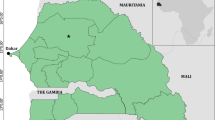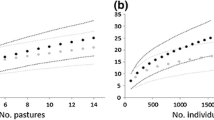Abstract
Grazed pastures have been historically used in Japan for animal production with little concern to biodiversity. However, pasturing has significant effects on biodiversity and productivity because it produces gaps in the distribution of vegetation due to animal activities. We hypothesized that different grazing activities would have effects on the diversity of plant species and forage quality in different ways and that the sward type would modify these effects. Therefore, we attempted to predict the diversity of plant species and changes in total nutrient content per area at the time since treatment on the basis of simulations of cattle activities in three pastures with different vegetation compositions. We created three ground types (grazed areas, cleared ground, and undisturbed areas) in three pastures (improved, partially improved semi-natural, and semi-natural pasture) and recorded the percentage cover of each plant within the plots. We repeatedly calculated the biodiversity indices from these community data by varying the sampling probabilities for each ground type, which provided us with the expected species diversity indices with the changing proportions of each ground type. Furthermore, we investigated the dry matter and forage qualities. For improved and partially improved semi-natural pasture, our models predicted that plant diversity increased as a saturating function of the proportion of cleared ground and grazed area relative to the undisturbed area, although our models also showed exponential curves for the semi-natural pasture. Forage samples from cleared ground plots and semi-natural pasture had the lowest forage quality among all pastures. Based on the predicted effects of cattle pasturing on the plant species biodiversity and forage quality, it may be more beneficial to maintain a small proportion of cleared ground in the improved pasture during intensive grazing.


Similar content being viewed by others
References
Agriculture, Forestry and Fisheries Research Council Secretariat (2000) Japanese feeding standard for beef cattle. Japan Livestock Industry Association, Tokyo
Bullock JM, Hill BC, Silvertown J, Sutton M (1995) Gap colonization as a source of grassland community change: effects of gap size and grazing on the rate and mode of colonization by different species. Oikos 72:273–282
del Pozo A, Ovalle C, Casado MA, Acosta B, De Miguel JM (2006) Effects of grazing intensity in grasslands of the Espinal of central Chile. J Veg Sci 17:791–798
Development Core Team R (2009) R: A language and environment for statistical computing. R Foundation for Statistical Computing, Vienna
Gallet S, Roze F (2001) Conservation of heathland by sheep grazing in Brittany (France): importance of grazing period on dry and mesophilous healthlands. Ecol Eng 17:333–344
Grime JP (1973) Competitive exclusion in herbaceous vegetation. Nature 242:344–347
Hill MO (1979) DECORANA: A FORTRAN program for detrended correspondence analysis and reciprocal averaging. Cornell University, New York
Ide Y (2003) Spatiotemporal change of pasture vegetation in mountainous slope land. Grassland Science 49:286–292 (in Japanese with English abstract)
Isselstein J, Jeangros B, Pavlu V (2005) Agronomic aspects of biodiversity targeted management of temperate grasslands in Europe: a review. Agron Res 3:139–151
Kohler F, Gillet F, Gobat JM, Buttler A (2004) Seasonal vegetation changes in mountain pastures due to simulated effects of cattle grazing. J Veg Sci 15:143–150
McCune B, Mefford MJ (1999) PC-ORD for Windows: Multivariate analysis for ecological data. version 4.0. MjM Software, Gleneden Beach
McNaughton SJ (1985) Ecology of a grazing ecosystem: the Serengeti. Ecol Monogr 55:259–294
Milchunas DG, Sala OE, Lauenroth WK (1988) A generalized model of the effects of grazing by large herbivores on grassland community structure. Am Nat 132:87–106
Morgan JW (1998) Importance of canopy gaps for recruitment of some forbs in Themeda triandra-dominated grasslands in south-eastern Australia. Aust J Bot 46:609–627
National Research Council (2001) Nutrient requirements of dairy cattle, 7th edn. National Academy of Science, Washington, DC
Okada M, Yoshihara Y, Sato S (2012) Effects of type and size of gaps created by simulation of cattle activities on the recovery and similarity of vegetation community. Grassland Sci 58:112–116
Pakeman RJ, Nolan AJ (2009) Setting sustainable grazing levels for heather moorland: a multi-site analysis. J Appl Ecol 46:363–368
Pakeman RJ, Small JL (2005) The role of the seed bank, seed rain and the timing of disturbance in gap regeneration. J Veg Sci 16:121–130
Panetta FD, Wardle DA (1992) Gap size and regeneration in a new-zealand dairy pasture. Aust J Ecol 17:169–175
Pavlu V, Hejcman M, Pavlu L, Gaisler J, Nezerkova P (2006) Effect of continuous grazing on forage quality, quantity and animal performance. Agric Ecosys Environ 113:349–355
Questad EJ, Foster BL (2007) Vole disturbances and plant diversity in a grassland metacommunity. Oecologia 153:341–351
Shea K, Roxburgh SH, Rauschert ESJ (2004) Moving from pattern to process: coexistence mechanisms under intermediate disturbance regimes. Ecol Lett 7:491–508
Tallowin JRB, Jefferson RG (1999) Hay production from lowland semi-natural grasslands: a review of implications for ruminant livestock systems. Grass Forage Sci 54:99–115
Tozer KN, Chapman DF, Quigley PE, Dowling PM, Cousens RD, Kearney GA, Sedcole JR (2008) Controlling invasive annual grasses in grazed pastures: population dynamics and critical gap sizes. J Appl Ecol 45:1152–1159
Tsutsumi M, Takahashi Y, Nishiguchi Y (2009) The feeding value of wild plants in abandoned cultivated lands and native pastures that differ in their dominant species. Grassland Sci 55:242–245 (in Japanese)
Vallentine JF (2001) Grazing management, 2nd edn. Academic Press, San Diego
Wardle DA, Nicholson KS, Rahman A (1995) Ecological effects of the invasive weed species Senecio jacobaea L. (ragwort) in a New Zealand pasture. Agric Ecosyst Environ 56:19–28
Watkinson AR, Ormerod SJ (2001) Grasslands, grazing and biodiversity: editors’ introduction. J Appl Ecol 38:233–237
White TA, Barker DJ, Moore KJ (2004) Vegetation diversity, growth, quality and decomposition in managed grasslands. Agric Ecosys Environ 101:73–84
Yamamoto Y, Saito Y, Kirita H (1997) Change rate of the extended summed dominance ratio, e-sdrz, of dominant species in Miscanthus type grassland by grazing. Jpn J Grassland Sci 42:315–323 (in Japanese with English abstract)
Yoshihara Y (2011) How does differential timing of grazing affect plant species diversity in improved and semi-natural pastures? J Integr Field Sci 8:73–77
Yoshihara Y, Ohkuro T, Buuveibaatar B, Undarmaa J, Takeuchi K (2010) Spatial pattern of grazing affects influence of herbivores on spatial heterogeneity of plants and soils. Oecologia 162:427–434
Acknowledgments
We thank S. Ogura and S. Tanaka of Tohoku University and the staff at the field science center for their kindness in helping with the field survey and other aspects of the study. This work was carried out with financial support from Tohoku University’s Global COE program “Ecosystem Adaptability Science for the Future” and the Sumitomo Foundation for Environmental Research (No. 083370).
Author information
Authors and Affiliations
Corresponding author
Electronic supplementary material
Below is the link to the electronic supplementary material.
Rights and permissions
About this article
Cite this article
Yoshihara, Y., Okada, M., Sasaki, T. et al. Plant species diversity and forage quality as affected by pasture management and simulated cattle activities. Popul Ecol 56, 633–644 (2014). https://doi.org/10.1007/s10144-014-0443-4
Received:
Accepted:
Published:
Issue Date:
DOI: https://doi.org/10.1007/s10144-014-0443-4




